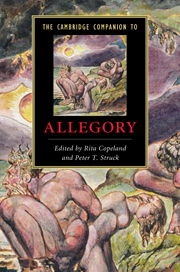Book contents
- Frontmatter
- Introduction
- Part I: Ancient foundations
- Part II: Philosophy, theology, and poetry 200 to 1200
- Part III: Literary allegory: philosophy and figuration
- 8 Allegory in the Roman de la Rose
- 9 Dante and allegory
- 10 Medieval secular allegory: French and English
- 11 Medieval religious allegory: French and English
- 12 Renaissance allegory from Petrarch to Spenser
- 13 Protestant allegory
- 14 Allegorical drama
- Part IV: The fall and rise of allegory
- Further reading
- Index
12 - Renaissance allegory from Petrarch to Spenser
from Part III: - Literary allegory: philosophy and figuration
Published online by Cambridge University Press: 28 January 2011
- Frontmatter
- Introduction
- Part I: Ancient foundations
- Part II: Philosophy, theology, and poetry 200 to 1200
- Part III: Literary allegory: philosophy and figuration
- 8 Allegory in the Roman de la Rose
- 9 Dante and allegory
- 10 Medieval secular allegory: French and English
- 11 Medieval religious allegory: French and English
- 12 Renaissance allegory from Petrarch to Spenser
- 13 Protestant allegory
- 14 Allegorical drama
- Part IV: The fall and rise of allegory
- Further reading
- Index
Summary
In such a long stretch of time, over 250 years, from roughly the middle of the fourteenth to the end of the sixteenth century, so much happened in allegorical theory and practice that I will have to be very selective, working by example rather than offering a comprehensive picture. I will discuss only heroic poetry with occasional glances at pastoral, the two classical genres commonly associated with allegory. For allegorical interpretation, the objects of study are the Aeneid and the Divina commedia. For allegorical writing, the discussion here will cover Petrarch and Boccaccio, Boiardo, Camoes, Tasso, and Spenser.
My approach will be topical. I will begin each topic with Petrarch and Boccaccio, who developed their position out of that created by Dante and his circle, and then proceed to show how later interpreters and poets made significant changes or explored special problems. Petrarch and Boccaccio set the parameters that involve two interlocking concepts and practices. First is the theory and practice of allegory itself and its varieties, the moral-psychological, the historical or euhemeristic, the physical and cosmological; and the second, the consequences of that theory, the varied attempts to control audience response.
Part one: The theory and interpretation of allegory
Ethical and psychological allegory
I begin with some remarks on terminology. The tendency in the fourteenth century was to talk of a literal and an allegorical sense, but the situation was still fluid enough so that other terms could be used as well.
- Type
- Chapter
- Information
- The Cambridge Companion to Allegory , pp. 162 - 176Publisher: Cambridge University PressPrint publication year: 2010
Accessibility information
- 4
- Cited by

